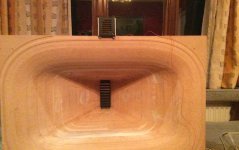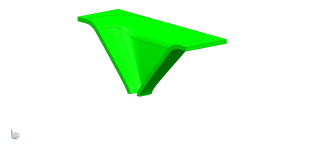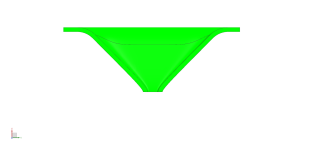I have previously ran a midrange AMT between 400hz and 7k in an OS rectangular horn, open at the back and have realised after trying it on a simple open baffle that I prefer the presentation of the horn. Whether it’s the directivity or the cardioid nature that the horn gives it don’t know. The horn was designed using the OS profile and super ellipses varying n=9 to n=4 to get the rectangular mouth and throat.



The horn measurements, offering so lower end boost. Since knocking up these temporary horns about 5 years ago, the only modification I have done is add an acoustic lens to break up the nasties you get from the horizontal bars , in the 2khz and 4khz range. So having watched the ATH thread with interest, I am wondering whether I can design a better horn? The mouth round off I did in CAD was just by eye.
So I am looking for advice, on the vertical and horizontal dispersion I used 60 degs and 90 previously, and whether there are any tricks that can improve the verticals.




The horn measurements, offering so lower end boost. Since knocking up these temporary horns about 5 years ago, the only modification I have done is add an acoustic lens to break up the nasties you get from the horizontal bars , in the 2khz and 4khz range. So having watched the ATH thread with interest, I am wondering whether I can design a better horn? The mouth round off I did in CAD was just by eye.
So I am looking for advice, on the vertical and horizontal dispersion I used 60 degs and 90 previously, and whether there are any tricks that can improve the verticals.

Last edited by a moderator:
Subscribed.
My recollection is you were using a TPL-150H on a larger wood horn, althought not as large as this. Is it that AMT in this 400-7000Hz horn?
My recollection is you were using a TPL-150H on a larger wood horn, althought not as large as this. Is it that AMT in this 400-7000Hz horn?
Hmm, a 60 deg vertical/90 deg horizontal WG requires a F -6 dB = 10^6/(60*400) = 41.67" H x 27.78" W.
No about 5 years ago I got a midrange AMT, which is 50mm x 125mm. (BEL AMT E500). The horn loading allows me to cross them a little lower. I still have the Beyma’s - but the extra octave at the bottom end nearly achieves my goal of not having a crossover in the critical listening range.
Started playing with ATH, looking at different profiles for a horn with an 89mm throat. Thinking I may have to morph a 2D horn profile into 3D using my super curves approach as not seeing a route in ATH, that will be quicker.
Started playing with ATH, looking at different profiles for a horn with an 89mm throat. Thinking I may have to morph a 2D horn profile into 3D using my super curves approach as not seeing a route in ATH, that will be quicker.
Thank you. I wasn't aware of the E500 AMT.
I recall your larger-than-stock wooden waveguides for the TPL that allowed reaching lower. How big were those and how low did you reach?
Looking forward to the development of the horn for the E500.
I recall your larger-than-stock wooden waveguides for the TPL that allowed reaching lower. How big were those and how low did you reach?
Looking forward to the development of the horn for the E500.
Been playing with ATH, without much sucess i feel i am randomly testing the software😉
I took the 2 profile horn example and modified some parameters. Not fully understanding what the profile is as its doesnt have the same parameters as the OSSE profile. Could i use 2 ROSSE profiles if i wanted? I assume one length controls both. Do the morph parmeters work with the 2 profile horn, as i tried a corner radii without any success.

Horn.Adapter = {
Height = 125
Segments = 0
Width = 50
}
Horn.Part:1 = {
H = {
a = 16
a0 = 3
k = 5.05
n = 2
q = 0.996
r0 = 62.5
s = 1.0
}
L = 1
Segments = 16
V = {
a = 10
a0 =1
k = .5
n = 2
q = 0.996
r0 = 25
s = 0.7
}
ZMap = 0.5,0.3,0.5,0.9
}
Morph.CornerRadius = 30
HornGeometry = 2
Length = 250
Mesh.AngularSegments = 64
Mesh.InterfaceOffset = 0
Mesh.InterfaceResolution = 6
Mesh.MouthResolution = 12
Mesh.RearResolution = 25
Mesh.SubdomainSlices = -2
Mesh.ThroatResolution = 6
Mesh.WallThickness = 10
Mesh.ZMapElementSize = 0.3,0.6,0.5,0.95
I took the 2 profile horn example and modified some parameters. Not fully understanding what the profile is as its doesnt have the same parameters as the OSSE profile. Could i use 2 ROSSE profiles if i wanted? I assume one length controls both. Do the morph parmeters work with the 2 profile horn, as i tried a corner radii without any success.
Horn.Adapter = {
Height = 125
Segments = 0
Width = 50
}
Horn.Part:1 = {
H = {
a = 16
a0 = 3
k = 5.05
n = 2
q = 0.996
r0 = 62.5
s = 1.0
}
L = 1
Segments = 16
V = {
a = 10
a0 =1
k = .5
n = 2
q = 0.996
r0 = 25
s = 0.7
}
ZMap = 0.5,0.3,0.5,0.9
}
Morph.CornerRadius = 30
HornGeometry = 2
Length = 250
Mesh.AngularSegments = 64
Mesh.InterfaceOffset = 0
Mesh.InterfaceResolution = 6
Mesh.MouthResolution = 12
Mesh.RearResolution = 25
Mesh.SubdomainSlices = -2
Mesh.ThroatResolution = 6
Mesh.WallThickness = 10
Mesh.ZMapElementSize = 0.3,0.6,0.5,0.95
Didn’t use ATH directly but used the OSSE curves as guide curves in my existing OS horn spreadsheet, with super ellipses, going from N= 10 at the throat to N= 5.8 at the mouth. The horn is 638mm wide 445mm tall and 236mm deep. Whether I try to simulate this before making sawdust is another question. Can a AMT be modelled successful in AKABAK, especially when it’s not horn-loaded.

- Home
- Loudspeakers
- Multi-Way
- New horn/wave guide for midrange AMTs